4 Questions to Help you Balance Traditional Batting with Modern Creativity
 How do we establish a balance between traditional values, and modern creativity and invention?
How do we establish a balance between traditional values, and modern creativity and invention?
As a coach I often hear the old school approach has stood firm and overcome even the best the world.
The clean and "conventional" stroke play of Jayawardene or Ian Bell.
The full face and physical presence of Matthew Hayden, intimidating bowlers with simplicity and power.
All of these players, and many more, build their successes upon traditional qualities of batsmanship that have stood the test of time.
But as young cricketers reach for the remote, they see the creative and expressive skills of AB De Villiers, David Warner and Tillakaratne Dilshan in the IPL. You'd be forgiven for reaching for the textbook and hurling it towards the bin.
With times a-changing, knowing where to focus training sessions, and how to structure practice is confusing. There is rarely a "one size fits all" approach. You have to consider the individual and group where possible.
Therefore let me arm you with a few questions that can hopefully direct your training session in the right direction.
1. What stage are you in development?
When considering your answer, think about what you want to achieve.
Do you want to create and exciting session to spark the imagination of your players, ensuring they come back next week? Would they benefit from simplistic ideas of technique or tactics?
When it comes to a single player; What is the individuals role within the side currently, and how would they like their role to progress?
A genuine number 11 who is regularly getting knocked over may benefit from some simplistic basics, where as a player looking to add options to their repertoire, could find experimenting with some more imaginative shots a better way to expand their game.
2. Which shots suit your level of cricket?
With younger cricketers, shots such as the ramp or reverse paddle look great in nets, but with limited pace on the ball, they're ineffective compared to drive or pull shots, encouraging players to create power themselves.
Similarly those playing senior cricket at a slightly lower level, may find that enough scoring opportunities coming from basic stroke play. There are plenty of half volleys and long hops anyway. So, there is a lesser requirement for other options.
That said, we should remember that shots are only as complicated as you make them. Players who have hockey as their first sport find the reverse sweep an easier method of rotating the strike than a drive. If it comes naturally and it works, keep going!
3. What format of cricket do you play?
Twenty20 requires multiple options to any given ball because you need to score quickly.
Longer formats of the game have less demand for such a range of skills. In short, you can "get away" with less shots when you have more time to play.
More options can always help (say in a run towards a declaration in a 4 day game), but you have to decide how often the opportunity to play these shots arises in your format, and how much practice time you want to devote to each circumstance.
4. What have you done recently?
It's always a good idea to keep your sessions fresh.
If you recent sessions have been very structured and regimented, with skills and drills that are boring or repetitive - no matter how beneficial they are - then throw in something new. Winters can be long, so strive to keep them on their toes.
Above all, try to carry some key awareness' with you at all times:
- Even the most elaborate and creative shots rely on some basic principles: balance and movement.
- Repetition is key. Understand the importance of different shots as part of their whole skill set.
- Cricket is enjoyable. If you stop having fun, you stop playing all together. So balance what's fun with what's productive to performance. Fun brings you back, but success makes you stay.
Where do you find yourself on the scale between "traditional" and "unorthodox"? Leave a comment and let know what you think.
- Login to post comments

